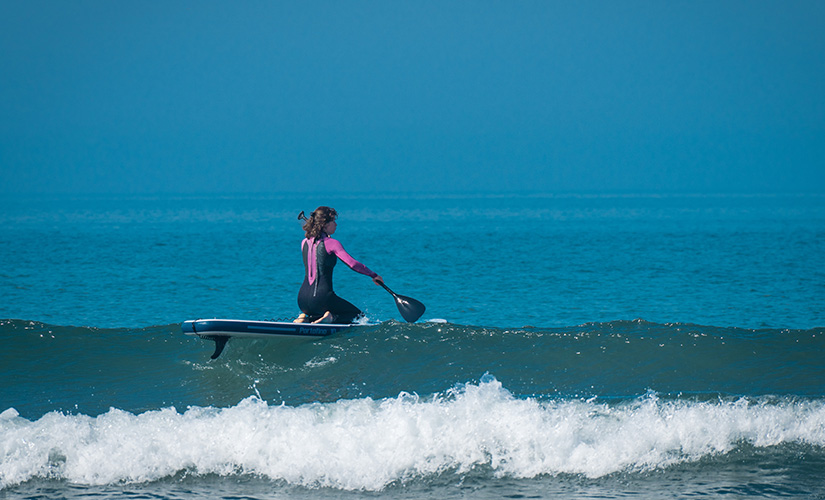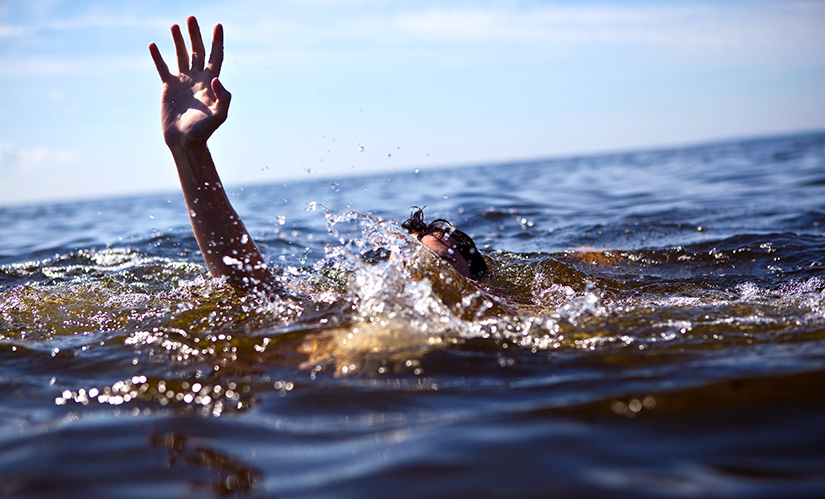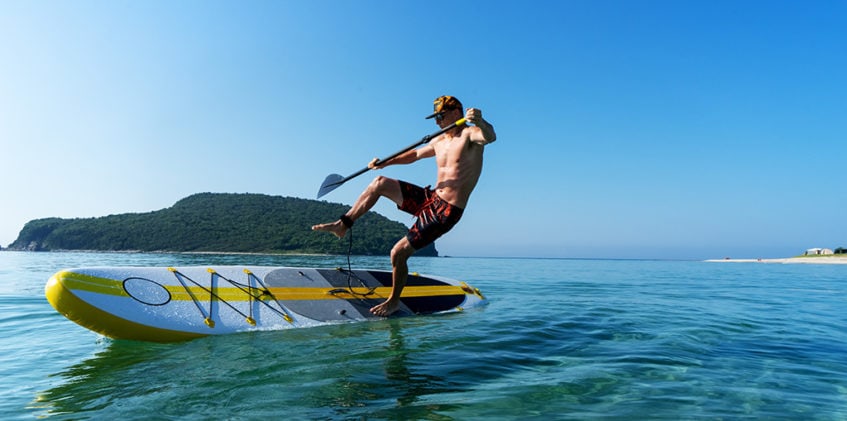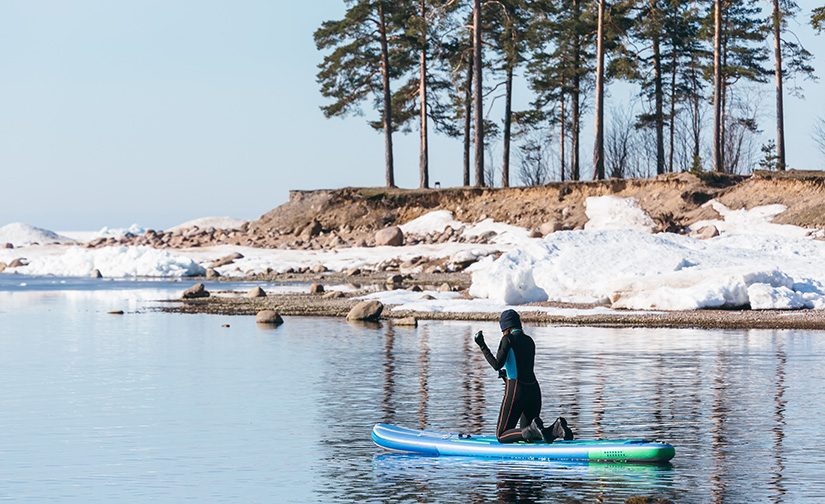Stand up paddle boarding can be a gentle activity, but it’s still a physical activity–and a water sport at that. If you think about it, there are some things that could go wrong. So it’s okay to have concerns.
Is paddle boarding dangerous? No, paddle boarding is a relatively safe activity. But the answer isn’t that simple. As you can imagine, there are a lot of variables and the degree of safety can vary. Besides, like anything else in life, SUP has its risks.
Fortunately, the associated risks are not particularly abundant. Plus, there are basic precautions you can take to greatly reduce those risks.
Let’s dive into the details.
Stand Up Paddle Boarding Is One of the Safest Water Sports
When you look at the 2021 USCG recreational boating statistics, you’ll realize that SUP is one of the safest water sports.
There were a total of 6104 accidents and only 25 of those involved stand up paddle boards. The numbers are slightly higher for other popular sports like kayaking (176) and canoeing (62).
What’s more, almost all of those accidents would have been avoided considering the leading causes, one of them being alcohol use.
So when you take everything into account, you’ll realize that paddle boarding is quite safe. But you have to be aware of the risks and how to avoid them.
8 Risks of Paddle Boarding
Every activity has risks–and stand up paddle boarding is no different. Let’s take a closer look at the most commonly associated risks of paddle boarding.
Cold Shock and Hypothermia
There’s no reason to let the seasons limit your paddling lifestyle because SUP is an activity for all seasons.
However, paddling in cold water means you now have to worry about cold shock and hypothermia.
It isn’t the paddling itself that’s dangerous but falling into the water is something that you have to expect. This goes for beginners and advanced paddle boarders alike.
If you fall into ice-cold water your skin temperature suddenly drops. You start experiencing involuntary actions such as quick breathing, dizziness, and even confusion. If you’re involuntarily panting you can inhale water in the process.
Unable to hold your breath and swim properly, with water constantly washing over your face, things could go wrong very quickly.
Risk of Drowning
Unfortunately, drowning is the leading cause of death in SUP accidents. This is the case with all the other recreational vessels too.
Paddle boarding is a water activity so drowning will always be a risk. However, it’s something you can avoid by taking simple precautions. If you check the data, you’ll see that in most of the drowning cases the paddle boarder wasn’t wearing a personal flotation device.
Other factors that may increase your risk of drowning include paddling in bad extreme water and weather conditions. Sometimes it’s just carelessness on the side of the paddler.
Sun Exposure and Dehydration
Paddling in the sun is awesome but it can quickly turn into a sour experience.
Being out in the sun without any kind of protection will cause sunburn in the short term. It may not be life-threatening but it’s painful and uncomfortable. In the long-run sun exposure could lead to serious damage and even cancer.
Paddle boarding is a demanding physical exercise even though it doesn’t feel or look like it. And when you’re paddling under the hot sun you’ll be losing a lot of fluids. This puts you at risk of dehydration and heat exhaustion.
Getting Caught Up in Adverse Conditions
Five of the paddle boarding accidents that occurred in 2021 were a result of bad weather and hazardous waters.
Harsh water and weather conditions can be dangerous when you’re out there on your paddle board. For instance, paddling against a strong wind isn’t fun and you may have trouble getting to shore. Besides, your body acts as a sail when standing, increasing resistance.
Extremely choppy weather may make it harder to stay onboard. And when you get caught up in a thunderstorm, being struck by lighting becomes a very serious risk.
Collision with Other Vessels
Sometimes you have no option but to go paddle boarding in a crowded area, even though it isn’t ideal.
When you’re in a crowded lake or ocean with motorized vessels zooming past you, you have to worry about collision.
As you can imagine, if you collide with a boat or jet ski while on your SUP you could get badly injured.
Dangerous Marine Animals
The water is home to tons of animal species–some of them cute and friendly, others deadly.
Most sea animals won’t go out of their way to attack a paddle boarder. However, they’re still wild animals and you can’t really predict their behavior. For example, there have been cases of sharks attacking paddle boarders.
Depending on where you’ll be paddling, you have to beware of sharks, snakes, alligators, and other dangerous animals.
Muscle Overuse and Injury
As I mentioned above, paddle boarding is more demanding than it looks. Even though it’s a gentle, low-impact exercise, injuries still do happen.
One of the main causes of muscle strain and injury in SUP is poor paddling technique. You end up relying on your arm and shoulder muscles too much and wear them out. After a while, you may start complaining about shoulder or elbow pain.
Muscle pain may also be a result of doing too much too soon. This is especially likely if you haven’t been physically active for some time, and your fitness level is poor.
Submerged Obstacles
Obstacles underwater–rocks, fallen trees, and other objects–can land you in serious trouble. It’s a real issue, more so when paddling in rivers.
If you accidentally fall off your paddle board and hit a rock the story may not end well. There’s also the possibility of your fin getting caught in something under the water, throwing you off balance. Your paddle board can get damaged in the process too.
10 Tips to Make Your Paddle Boarding Experience Safer
We’ve talked about the risks associated with paddle boarding. So now let’s discuss how to avoid them.
Research Your Paddling Location
In paddle boarding preparation is key, and that starts with knowing the spot well. If you will be going to a new location, you want to make sure you know what to expect.
What are the potential dangers? What animals might you encounter? If it’s a river what’s its level of difficulty?
Asking and answering all these questions ensures that you won’t be caught by surprise. If possible, talk to local outfitters and paddle boarders in that area. You’ll learn a lot.
Always Check the Weather Forecast
I can’t emphasize this enough.
From the 2021 recreational boating accident data, 456 of the accidents were due to hazardous water and weather.
You don’t want to find yourself paddling into a strong wind on your way back when you’re already worn out. Or to be suddenly caught in a thunderstorm when you’re too far from the shore.
Knowing what the weather and water conditions will be like allows you to plan your trip. This way, you won’t run into a life-threatening surprise.
Wear Your PFD and Leash
One of the most important safety precautions for SUP is the proper use of safety equipment. There are two things that you must never go into the water without–a life jacket and a leash.
Drowning is the leading cause of death in recreational boating. About 74% of all deaths in this discipline in 2021 were caused by drowning. The two most common accident types in the drowning cases were capsizing and the person falling overboard.
A paddle board leash ensures you’re not separated from your SUP when it capsizes or you fall off. You’ll still have a floating device to help you get back to safety.
A life jacket prevents you from drowning by keeping your head above the water when you fall off.
Learn How to Paddle Correctly
Before you pick your new board and start paddling, take some time to learn how to do it right.
Poor paddling techniques will have you getting worn out quickly and you could get an injury too. To avoid straining your muscles and hurting yourself, you need to use the bigger muscle groups. Most of your power should come from your core and back muscles.
To do this, you have to master how to make a proper paddle stroke.
Sun Protection Is a Must
Most people don’t consider sun damage a risk when it comes to SUP. But it is and it could cause serious problems for you in the future.
Wear sunscreen before you go out and if you jump in for a swim, reapply. You could also get a rash guard, sun hat, and sunglasses for extra protection.
I recommend avoiding the hot midday sun altogether and paddling in the morning or evening hours.
Bring enough drinking water as well and make sure you stay hydrated throughout the day.
Respect Marine Animals
A fun aspect of paddle boarding is getting to see beautiful animals in their natural habitat. There are few things that are more magical than paddling alongside turtles, dolphins, and other marine animals.
However, to keep yourself and the animals safe, stay out of their way and observe from a distance. Never try to touch or get too close to animals in the water, especially dangerous ones like sharks, snakes, and alligators.
Avoid Drugs and Alcohol While Paddle Boarding
Four out of the 25 paddle boarding accidents in 2021 were caused by alcohol. They could have been easily avoided.
Alcohol affects your judgment which can be dangerous when you’re out on the water, even in calm conditions.
One small mistake and things can go south quickly. Avoid alcohol and drug use when paddling. You want to be fully sober and alert, able to make the right decision in any situation.
Dress for the Weather
You can wear pretty much anything (within reason) when paddling in warm weather, as long as it’s comfortable and quick-drying. But in the colder months, you’ll need to protect yourself from the cold air and water.
A good paddle boarder knows that you should always prepare for immersion. Do this by wearing appropriate clothing and layers in case you fall into cold water. Remember that even with a life jacket cold shock and hypothermia still pose a serious threat.
Beware of Boat Traffic
Collision with other recreational vessels is actually common. If you collide with a big motorized boat while on your SUP the result could be fatal.
Try as much as possible to stay away from crowded areas with a lot of boat traffic. If you don’t have many options, wear bright clothing and have SUP lights when paddling at night. The idea is to make yourself visible to everyone in the water.
Go with Other Paddle Boarders
Lastly, find some paddling buddies so you don’t always have to go alone. You can take care of each other in case of anything.
There are instances when a paddler may not be able to help himself, like when he’s knocked unconscious. Going with friends, especially when exploring the open water or secluded areas is important.
Join a paddling club or take a class to meet fellow paddlers.
Frequently Asked Questions About Paddle Boarding Safety
Is It Dangerous to Paddle Board Alone?
No, paddle boarding alone isn’t dangerous but it depends on your skill level and your paddling location. Either way, it’s better to go with friends.
When Should You Not Paddle Board?
You shouldn’t paddle board when the weather and water conditions are rough. If it’s too windy, the water is too choppy, or the situation is too advanced for you, stay away from the water.
Is Paddle Boarding Safe for Non-Swimmers?
Yes, paddle boarding is safe for non-swimmers. But it’s best to do it in flat water, close to the shore, and surrounded by people who can swim (or at the very least, with a paddling partner who can swim). The water shouldn’t be too deep either, in case you fall in – just higher than waist height is a safe bet.
Are Paddle Boards Safer Than Kayaks?
This is hard to say because it depends on how careful you are as a paddler. Both paddle boards and kayaks are safe as long as you adhere to all the safety precautions.
Do Paddle Boarders Get Attacked by Sharks?
Sharks don’t go out of their way to attack paddle boarders. But they may get curious or mistake your SUP for food. It is rare but it has happened before. Don’t go into the water where there have been shark sightings. If you ever see a shark while paddling, stay calm and quickly get out of the water.
Summary
Is paddle boarding dangerous? No. Paddle boarding is one of the safest water sports. This, however, doesn’t mean that there aren’t risks.
Accidents happen. Additionally, ignoring safety precautions that seem small and simple can have serious repercussions.
You can greatly reduce the risks of paddle boarding by wearing your PFD and leash. Research your paddling location, check the weather forecast, and create your paddling plan in advance. Always dress for the water temperatures.
Avoid drugs and make sure you are visible while out on the water.
Lastly, find some paddling friends. It’s fun and safer.
Happy paddling!





